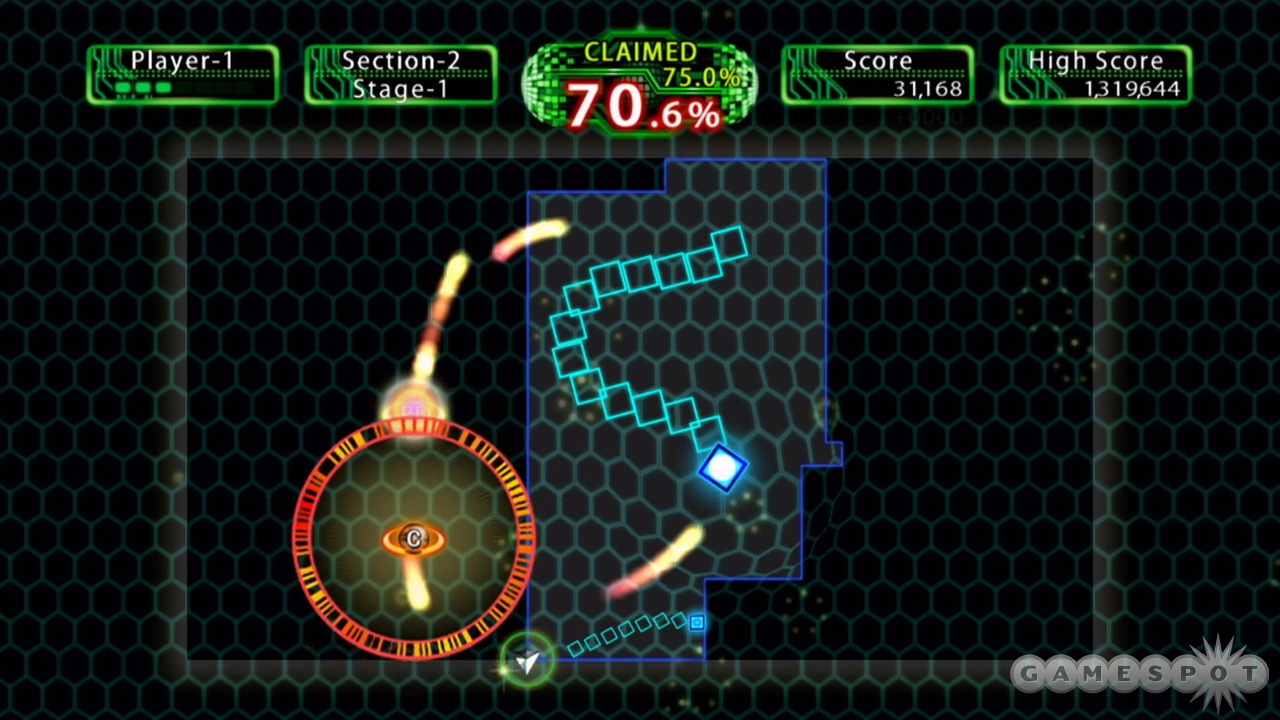The original Qix may not have made as big a splash as its contemporaries (Pac-Man, Centipede, and the like), but it still rode the wave of the early 1980's arcade revolution. In it, your goal was to fence off the majority of a grid by connecting one point to another by drawing lines with your marker while avoiding the elegant, unpredictable entity called the qix that floated and warped about the playing field. It's a simple but fun mechanic that has spawned numerous clones and remakes over the years, including this newest iteration, Qix++. However, whether you have fond memories of the original or any of its clones or are new to the formula, you should avoid this short and dreary remake. Not only does it fail to capture the minimalist joy and challenge of the original, but its 20 minutes of gameplay also costs 800 Microsoft points ($10). And that's far too much to spend on an unbelievably short game that completely misses the point.
At least the basics haven't changed. You control a marker that roams the inner edge of the playing field's perimeter. The goal is to capture a certain percentage of the grid by drawing lines through the open grid and creating rectangles and other shapes. These fenced areas then fill in with solid color and their edges become part of the grid's perimeter. Meanwhile, the qix bends and twists about the grid's innards; if you run into it while cutting a line through the field, you lose a life. Enemies called sparx occasionally skim the grid's perimeter as well, and you can avoid them or even destroy them by cutting into the dangerous playing field and trapping them. Qix++ adds three new features in an attempt to energize the simplicity. Firstly, you can trap power-ups that may provide you with extra lives or shrink the qix to a miniscule size, for example. Secondly, there are different types of qix with different behaviors. And lastly, you can earn points that you apply between rounds to four different attributes: moving speed, drawing speed, your number of shields (available lives), and luck. But don't ask what luck is; you won't notice any effect on gameplay when applying points to it, and the game offers a meaningless description of its actual function.
These aren't bad additions, but they don't make up for what Qix++ strips from the formula: two different cutting speeds. In the original Qix, you had two different drawing speeds; the areas filled in when drawing slowly resulted in more points than if you drew quickly, but the sluggish speed left you more vulnerable to the qix. Qix++ removes this risk-versus-reward element, and thus removes challenge and tension. In fact, the game is much, much easier than the arcade innovator. You can blow through both sections (16 levels total) in about 20 or 30 minutes if you don't care about your score. The only bit of challenge comes from shooting for high leaderboard scores, which means filling in the greatest percentage of the board you can with your final line. To do so, you'll use traditional Qix strategies, like trapping the qix by drawing thin strips, which sets you up to fill in enormous sections of the grid in the blink of an eye. But even if you shoot for big percentages (after a few play-throughs, it's a cinch to fill in over 90 percent of every level), there's absolutely no challenge here. There are too few sparx to force you into the grid's interior and certain power-ups can make the levels supereasy and supershort. It's all a great big bore.

Like other souped-up versions of old arcade games, Qix++ adds a bit of neon sheen to the 2D visuals and sets the game to a generic techno beat. The visuals aren't as annoyingly messy as they so often are in other updated classics, but they don't have any personality or flair. A few fleeting sound effects recall the satisfying digital buzzes and blips of the original, but the irritating music makes these nostalgic flashes too easy to miss. Qix++'s online and local multiplayer is even more irritating, given that it's highly defective. Up to four players draw lines on the same grid, gunning for the highest score, which sounds like it could be fun but is in practice absolutely abysmal. The game pauses each time a player captures an area, which leads to a halting, bumpy pace that is not in the least bit enjoyable. Additionally, the scoring appears to be broken, given that there is no indication of what the victory parameters are. The winner's crown doesn’t go to the player with the highest score, most remaining lives, or even most kills, so the results seem completely random.
If you need more proof that Qix++ is an incomplete game, consider this: There are unpopulated online leaderboards for sections that aren't in the game. Apparently, the game was intended to include more levels than actually exist. If you have fond memories of dropping quarters into Qix cabinets back in the day, then don't besmirch your past by playing this "modernized" version. It has none of the challenge and none of the tense excitement that characterized the original, nor is it fun or compelling on its own terms. Stay away from this dud.